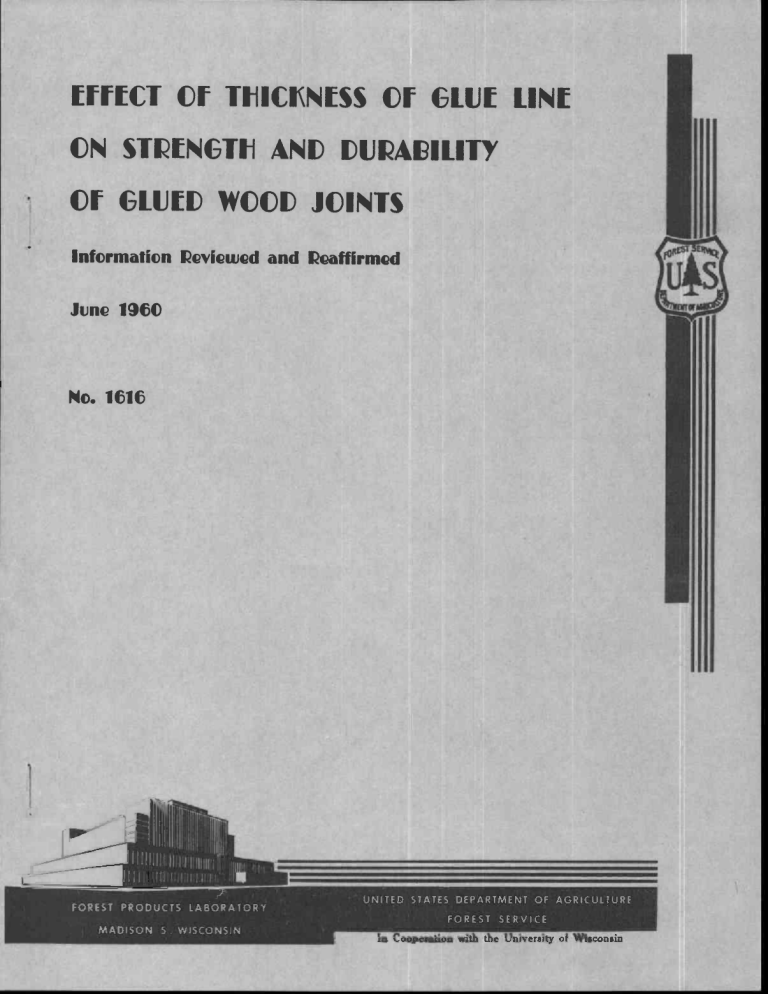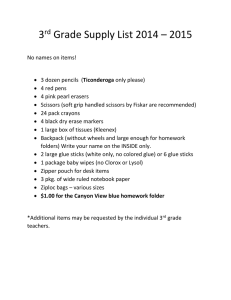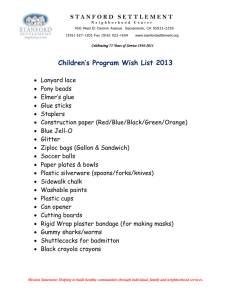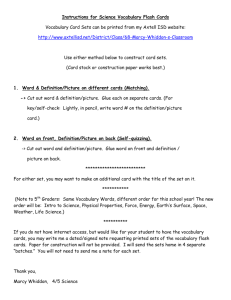EFFECT Of THICKNESS Of GLUE LINE ON STRENGTH AND DURABILITY

EFFECT Of THICKNESS Of GLUE LINE
ON STRENGTH AND DURABILITY
Of GLUED WOOD JOINTS
Information Reviewed and Reaffirmed
June 1960
No. 1616
FOREST PRODUCTS LABORATORY
MADISON 5. WISCONSIN
UNITED STATES DEPARTMENT OF AGRICULTURE
FOREST SERVICE
Ia Cooperation with the University of Wisconsin
EFFECT OF THICKNESS OF GLUE LINE ON STRENGTH AND
DURABILITY OF GLUED WOOD JOINTS-
By
2
- Forest Service
U.S. Department of Agriculture
MIIMMI GO
Glue lines in wood joints are generally from 0.002 to 0.005 inch thick, but thicknesses exceeding this range frequently occur in assembly operations because of poorly fitted surfaces or difficulty of applying preesure adequately and uniformly during the curing period. Abnormally thick glue lines are commonly - regarded as inferior in strength and durability to-those within the normal thickness range, and in glued wood structures designed to close tolerances, such as aircraft parts, thick glue , lines are usually considered a basis for rejection.
The purpose of the work here reported was to obtain factual data on the relation between thickness of glue line and strength, and durability of glued joints.
'Panels were made of two-ply veneer with seven different glues in six glue-line thicknesses. Lap-joint specimens cut from the panels were exposed to various conditions of heat and moisture, and periodically some were tested in shear to4etect any change in joint strength with time of exposure. The data were analyzed for evidences of the influence of glue-line thickness on the rate of loss of joint strength. This report presents the results of the study after the specimens had been exposed for 24 months.
The tests showed that shear strength decreased with increase in thickness of the glue line, but the durability; was not significantly affected by the thickness. The different glues varied in performance. The casein glue was adversely affected by moisture; the urea glues in general were weakened most by a hot, moist condition
(158° F., 20 percent relative humidity); the phenol and resorcinol glues did not change much under the various conditions of the exposure.
H. D. Bruce.
.?Maintained at Madison, Wis., in cooperation with the University of
Wisconsin.
Report No. 1616
Glues Tested
Seven commercial glues of the following types were tested in this study:
(A) Prepared casein glue with 5 percent tetrachlorophenol as preservative.
(B) Room-temperature-setting urea-formaldehyde resin, passing Specifica.
tion AN-G-8, "Glue; Cold Setting Resin."
(C) Room-temperature-setting urea-formaldehyde resin, with liquid compensator for resistance to crazing.
(D) Room-temperature-setting urea-formaldehyde resin, with a film pH of
1.73.
(E) Intermediate-temperature-setting phenol resin..
(F) Room-temperature-setting urea-formaldehyde resin, claimed by the manu.
facturer to have desirable gap-filling properties.
(G) Room-temperature-setting resorcinol-formaldehyde resin, passing AAF
Specification 14124A, "Glue; Low-temperature-setting Resin (Phenol,
Melamine, and Resorcinol Base)."
The glues were mixed and used according to manufacturers' directions, with the exception of Glue D, for which 2 percent of ammonium chloride per 100 parts of nonvolatile urea-formaldehyde resin was employed as the catalyst to achieve a film pH well below 2.5.
Preparation of Test Specimens
The panels were made of 1/8-inch yellow birch veneer, 5 by 12 inches, with the grain parallel to the 5-inch dimension. The veneer was conditioned to equilibrium in air at 80° F. and 65 percent relative humidity before gluing.
The panels were prepared with wet glue-line thicknesses of normal joints
(0.005 inch or less), and 0.010 (1/100), 0.017 (1/60), 0.031 (1/32),
0.050 (1/20), and 0.063 (1/16) inch.
The joints of normal thickness were made by gluing together two faces of the 1/8-inch yellow birch veneer panels. Seven to eight grams of glue were spread on each of the surfaces to be glued.
The thicker glue lines were prepared by inserting between the faces two birch veneer shims of the desired thickness and 1-3/4 inches wide and
12 inches long, alined with the edges of the veneer so as to leave a channel at least 1-1/4 inches wide between the shims down the middle of
Report No. 1616 -2-
the panel (fig. 1). A thin layer of glue was spread on one face ply and on one surface of each of the two shims, the shims immediately placed in position on the coated face, and the central channel between them filled with glue by pouring and spreading with a brush. A generous layer of glue was then applied centrally along the other face ply, which was quickly placed, glue side down, on the glue-covered shims, taking care to avoid entrapping air bubbles.
An exception to this procedure for thick glue-line panel preparation was made for the panels with 1/20- and 1/16-inch shims glued with the intermediate-temperature-setting phenolic glue, F, and the resorcinol glue, G, inasmuch as these glues were too thin in consistency to remain in the wider gaps when spread in the manner previously described. For these panels, the faces and shims were thinly spread with glue and pressed into panels in frames to hold the panels upright. The lower end gap of a panel was filled with putty, the glue poured into the vertically oriented channel until it was full, and the top-end gap sealed with putty.
From 15 to 20 minutes closed assembly time was allowed on all panels before pressure was applied.
On joints of normal thickness, pressure of 150 pounds per square inch was applied during drying. For panels prepared with thick glue lines, the unit pressure of 150 pounds per square inch was applied only to the surface area of the shims. The glue in the central channel between the shims was not under pressure because the ends, except those puttied, were left open to allow air and excess glue to escape. In the panels in which the gap ends were sealed with putty, the trapped glue also was under little or no pressure.
Glue E was cured in a kiln at 200° F. for 20 hours. The other glues were cured at room temperature, about 75° F., for at least 12 hours. After the panels were removed from the presses, they were conditioned for at least 7 days at 80° F. and 65 percent relative humidity before being cut into test specimens.
Ten test specimens were prepared from each 5- by 12-inch panel in the manner customarily employed for plywood shear specimens. Each specimen was 1 inch wide and 3-1/4 inches long, with saw cuts, spaced 1 inch apart, through the glue lines to the opposite face (fig. 1). Special care was exercised in making the saw cuts so that the kerf would be barely through the glue line without cutting into the opposite face.
The 10 specimens cut from each panel were separated into 10 groups, using random number tables to determine the distribution among the groups so that no panel would be represented by more than 1 specimen in each group. Two of the groups furnished specimens for the dry and wet shear tests to provide the control values for the original quality of the joints before exposure, as well as a reserve supply for supplementary tests
Report No. 1616 -3-
that might later be desirable. The other eight groups were subjected to four exposure conditions, two groups in each condition; the specimens of one group to be tested dry, the specimens of the other to be tested wet.
The four exposure conditions were as follows:
(1) Continuously, 80° F. and 30 percent relative humidity.
(2) Alternately, at 80° F., 2 weeks at 97 percent relative humidity and
2 weeks at 30 percent relative humidity.
(3) Alternately, 2 days soaking in water at 80° F., and 12 days drying at 80° F. and 30 percent relative humidity.
(4) Continuously, 158° F. and 20 percent relative humidity.
Method of Test
Testing was performed on a standard plywood shear testing machine, loading at approximately 750 pounds per minute. To obtain control values for the original shear strengths, 20 specimens for each thickness of glue line and each type glue were tested dry and 20 wet, after previous conditioning for at least 1 week at 80° F. and 30 percent relative humidity. The specimens under exposure were tested at intervals of
1, 2, 4, 8, 12, 18, and 24 months. At the end of each exposure period,
10 specimens of each glue type and glue-line thickness were randomly selected from each of the 8 remaining groups for testing. Those tested dry were always conditioned for at least 5 days at 80° F. and 30 percent relative humidity prior to testing, while those tested wet were immersed in water at room temperature for 48 hours before testing. Thus, for each glue at each test period, 10 specimens from each of the 6 glue-line thickness classes were tested dry and 10 wet. The percentage of wood failure for each specimen tested was estimated and recorded.
Results and Discussion
In setting; all the glue lines lost solvent and shrank, so that the thicknesses of the glue lines were less when dry than when wet. The dry glue lines were measured by a traveling microscope, and the average thicknesses from measurements on 40 specimens for each glue and shim thickness are given in table 1. By comparing the glue-line thickness with shim thickness in table 1, it is possible to estimate the shrinkage that occurred when the glues hardened. The casein glue, A, exhibited the greatest shrinkage on setting, while the resorcinol resin, G, or the urea-formaldehyde resin, with crazeproof liquid, C, shrank the least.
Report No. 1616
-4-
The type of wood failure of the specimens with thick glue lines was quite different from that of those with thin glue lines, which more nearly approximated a true shear failure along the grain of the wood. This may be explained by the fact that the greater the distance between the wood shearing surfaces in the specimens, the greater the eccentricity, and hence, the greater the torsional force upon the glue. This amounts to having the force, applied to the glue, line by the testing machine, act through lever arms of different lengths in breaking the joints. The typical failure in the thicker glue lines of the stronger glues consisted of a series of parallel tension cracks across the glue line, normal to the direction of pull and with the plane of the breaks sloping at -about
45° to the direction of pull. After the original tension failure occurred, the glue line was broken into a number of segments, diamond shaped in cross section, that rotated as the two parts of the lap joint slipped past each other. The surfaces of these rotating glue segments in contact with the wood exerted a cleaving force on the surface fibers, and usually a layer of fibers of varying thickness adhered to the glue.
Table 2 gives the average numerical value for the percentage of wood failure for each group of test specimens before exposure and after 24 months of exposure at the different conditions. The percentages of wood failure were generally lower for the thicker glue lines than for the thin glue lines, with rather pronounced differences for the different glues. •The room-temperature-setting urea-formaldehyde glue with low pH, glue D, made the poorest showing, with only the thinnest glue line exhibiting appreciable wood failure, and even this fell off to almost zero after 18 months at 80° F. and 30 percent relative humidity. The casein glue, A, when tested in the dry condition before exposure, gave fairly high wood failure values for the two thinnest glue lines, but nearly zero values for all greater thicknesses. The three roomtemperature-setting urea-formaldehyde glues with pH above 2.5, B,C, and
F, showed wood failure values decreasing with increasing thickness, and for each thickness, decreasing slowly with time, with the exception of the specimens exposed to 158° F. and 20 percent relative humidity, at which exposure the decrease with time was rapid. Both the intermediatetemperature-setting phenol and the room-temperature-setting resorcinol resin glues, E and G, showed, in general, slightly decreasing percentage values with increased thickness of glue line, but there was no significant decrease with time in any of the exposure conditions.
The shear strength data for all glues and exposure conditions are presented graphically by plotting shear strength versus elapsed time of exposure in figures 2 to 15. The slope of the curves presented in these figures represents the rate of change of shear strength with time of exposure. Since these curves for the different glue-line thicknesses are essentially parallel within each figure, it can be concluded that, for the conditions represented by this study, the rate of change of shear strength was not significantly affected by glue-line thickness; hence, the durability of the thick glue lines was equal to the durability of the thin glue lines.
Report No. 1616 -5-
Glues A and D were affected most by moisture. In the soaking and drying cycle, all specimens with glue A disintegrated before the end of the fourth month of exposure (figs. 2 and 3), and also all except the two thinnest glue lines of glue D (figs. 8 and 9). In the alternating high and low humidity exposure, the percentage of wood failures dropped to zero with all except the two thinnest glue lines of glue A, and with all glue D specimens (table 2). Some of the glue D specimens (1/16-inch thickness) had fallen apart as early as the eighth month of exposure
(figs. 8 and 9).
The family of curves in each figure shows, with few exceptions, a definite decrease in initial shear strength with increase in glue-line thickness.
This difference in shear strength could result from two causes--(1) the increase in offset of the two plies of the lap joints with increase in glue-line thickness, and (2) a decrease in physical strength of the glue with increase in thickness.
In an attempt to estimate the relative importance of these two causes, panels were prepared of two faces of 1/8-inch veneer separated by sheets of 1/100-inch veneer up to five in number. All veneer was of yellow birch, and the grain directions of all sheets and face plies were parallel. These assemblies were glued together under a pressure of 150 pounds per square inch at room temperature with the resorcinol glue, G, and specimens were cut as for the thick glue-line specimens previously described. In this way, specimens were made similar to the two-ply lap joints with thick glue lines except that, instead of a single thick glue line between the face plies, an equal thickness was built up of a series of one to six thin glue lines interspaced with thin sheets of veneer.
The average strength results of shear tests on these lap-joint specimens with multiple thin glue lines are plotted against the total thickness between the face plies (shown as the broken line in fig. 16). Also plotted (as solid lines) are the average strength results obtained on the specimens made with single thick glue lines of the several glues.
The strength of the multiple thin glue-line specimens, as measured in the shear test machine, decreased as the distance between the face plies increased because of cause (1), the effect of offset. The decrease was not as great, however, as for the single thick glue-line specimens made with the same glue, G. Thus, specimens made with this glue with a single glue line 0.040 inch thick were approximately 265 pounds per square inch lower in strength on the average than specimens with a glue line of normal thickness, 0.005 inch; whereas with the multiple thin glue lines, the corresponding difference was only 170 pounds per square inch. The difference between 265 and 170 was presumably due to cause
(2), greater characteristic weakness in thick than in thin glue lines.
If this assumption is correct, from the position of the curves for glues
A, B, D, and G in figure 16, urea-resin glue, B, would seem to be characterized by greater weakness in thick glue lines than the resorcinol glue, G, and casein glue A and urea glue D even more than glue B. The curve for glue D parallels closely that for glue A, and the curve for
Report No. 1616
-6-
glue E nearly coincides with that for glue G. The curve for glue C parallels that for the multiple thin lines of glue G at approximately 250 pounds per square inch lower level, indicating that, although this urea glue characteristically showed less strength than glue G, it did not reveal inherent structural weakness as its glue lines became thicker.
By considering the wood failure values along with the general appearance of the glue lines after testing, it was possible indirectly to get further evidence as to whether decreased physical strength was in part responsible for the lower joint strengths obtained on specimens with the thicker glue lines. All specimens made of glues A, B, and D with 0.031-,
0.050-, and 0.063-inch shims failed with conspicuously less wood failure than the thinner lines of the same glues. The thick glue lines formed by casein glue A particularly, and to a lesser extent by urea glue B, were quite porous in structure. Those formed by urea glue D were both porous and crumbly. The other four glues, however, exhibited, for the most part, relatively high wood failure even in the thickest glue lines, and showed no evidence of structural weakness that might have influenced the strength values. The different types of glues differed in the rate of loss of strength with thickness. Glues that have a tendency to foam when mixed, to set with a porous structure, or to craze severely after setting would be less desirable for use where thick glue lines may occur.
From these observations and the data of figure 16, it may be concluded that the decrease in shear strength with increase in glue-line thickness
is caused wholly or in part by differences in eccentricity in loading the specimens during the testing operation, but for some glues, decrease is caused in part by less strength of the glue with greater thickness.
Conclusions
On the basis of dry and wet shear tests made on 1/8-inch birch veneer lap-joint specimens glued with seven types of glue and exposed to four, different temperature and moisture conditions, it was concluded that:
(1) Shear strength decreased with increase in thickness of glue line, and this decrease was attributable wholly, or in part, to differences in eccentricity of test specimen due to difference in glue-line thickness.
Eccentricity seemed to be the entire cause in the case of glues C and F, and the major cause in the case of glues E and G. Increase in structural weakness with increase in glue-line thickness was a contributing cause in the case of glue B, and probably the major cause in the case of glues
A and D, which formed porous, crazed, thick glue lines.
(2) In tests extending up to 2 years, rate of change of shear strength with time, or durability of the joint strength, was not affected by glueline thickness in the four exposures tested.
Report No. 1616 -7-
(3) The percentages of wood failure were generally somewhat lower for the thicker glue lines than for the thin glue lines, with rather pronounced differences for the different glues.
(4) The change in wood failure values with time of exposure varied with the type of glue and the exposure. For the urea glues, the wood failure values fell off with time and were greatly reduced by the high temperature exposure (158° F., 20 percent relative humidity), but the change was not significant for the phenol and resorcinol glues. Phenol and resorcinol glues were not affected adversely by moisture nor by hot, moist exposure.
Although percentages of wood failures were high in all tests of specimens glued with phenol glue, they were usually somewhat higher when specimens were tested wet than when similar specimens were tested dry. Specimens glued with resorcinol glue showed similar trends though not so consistently. For the casein glue, the wood failure values fell off in the moist exposures but not significantly in the hot exposure.
Note
It should be emphasized that these conclusions were drawn from thick glue lines formed from glues that, with the exception of pressure, were used under good gluing, conditions. The conclusions would probably not be applicable to thick glue lines that resulted from an improperly formulated mixture or from excessive assembly time.
Report No. 1616 -8- 2-29
Table 1.--Average glue-line thicknesses, when dry, of the lap-joint specimens prepared with shims of various thicknesses
Shim : thick-: ness : A
Thickness of dry glue linel with different glues
•
F G
: Casein: Urea : Urea plus : Urea : Phenol : Urea : Resor-
:compensator: pH :intermediate: "gap : cinol
: 1.73 :temperature :filling":
Inch : Inch : Inch : Inch : Inch : Inch : Inch : Inch
0.0
: 0.004 : 0.002 : 0.002
: 0.003 :
.010
: .006 : .006
: .008
: .011 :
.017
: .008 : .011 :
.031 : .016 : .024 :
.050 :
.063 :
.023 :
.035 :
.035
.044 :
:
.013
.026
..040
.051
.013 :
.023 :
.037 :
.042 :
0.002
.008
.013
.025
.035
.047
0.003 : 0.004
.007 : .010
.011 : .016
.023 : .027
.034 : .040
.044 : .048
!Thickness of the glue line was measured after drying with a traveling microscope, using the average of 40 specimens for each measurement given.
Report No. 1616
Table 2.--Average percentage of wood failure in shear tests of lap-joint specimens with glue lines of different thicknesses before exposure and after 24 months at 4 conditions ness :
(shim):
• :
Glue : thick-:
Wood line : failures
Percentage of wood failure after exposure for 24 months at-before : exposure
•
80° F.,
30 percent : humidity : relative
High - low : Soaking and : dryin cycle4
158° F.,
20 percent cyclel.• relative humidity humidity
:
:Testfd:Tested:Tested:Tested:Tested:Tested:Tested:Tested:Tested:Tested dry!•-: wed.. : dry' :.wet? : dry' : wet? : dry l : wet? : dry' : wet?
:
: cent : cent :
:
:
:
:
:
:
:
:
•.
GLUE A (CASEIN)
None : 67 :
2 : 30 : 1 : 16 : 0 : 0 : 0
1/100 24 :
: 56 :
1 : 29 : 2 : 16 : 4 : 0 : 0 : 0 :
0
1
1/60 : 2: 0: 0: 0: 0: 0: 0 :
1/32
1/20
1/16 :
:
:
1: 0: 0: 0: 0: 0: 0:
0
0
: 1 0 : 0: .
0:
: 0:
0:
0
0
0: 0: 0: 0: 0: 0
0: 0: 0.
0: 0: 0: 0: 0.
0
GLUE B (UREA)
None : 100 : 98 : 84 : 98 : 28 : 22 : 72 : 49
1/ 100 : 99 : 92 : 59 : 42
: 14 : 19
1 : 33 : 27 : 45 : 2 : 0
1/60
1/32
1/20
1/16 :
:
:
: 52
31
21
5 :
:
:
: 48
27
10
14 :
:
:
: 1
1
0
0 :
:
:
: 53
21
0
0 :
:
:
: 1 :
3 :
7 : 0 : 30 : 0 : 7
5 : 0 : 6 : 0 : 0
3 : 2 : 0 : 1 : 0 : 1
2 : 4 : 0 : 0 : 0 : 0
GLUE C (UREA PLUS ANTICRAZE LIQUID)
None : 100 : 98 • 99 : 77 : 56 : 36 : 61 : 21 : 0
1/ 100 : 81 88 : 41 23 : 98 : 96 : 18 : 17 : 0 :
: 10
0
1/60
1/32
1/20
1/16
:
•.
:
77
62
72
74
•.
•.
•.
•.
72
58
19
39
• .
• .
•
23
11
19
30 :
22 : 100 .
89 .
13
11 : 100 •.
2 : 62 •.
31 •.
0 •.
11 : 31 .
59 •.
9 •
4 : 0 : 0
1 :
1 :
0 :
0 :
0
0
5 • 0 •.
0 •.
0 .
0
GLUE D (UREA WITH LOW FILM pH)
None : 90 : 94 : 67
1/100 : 0 : 0 . 0 :
1/60 :
15
0 •.
3 : 0 : 0 : 0 •.
•.
0
0 •.
0 :
1/32 : 0 0: 0 : 0: 0 :
1/20 : 0:
1/16 : 0 •.
0:
Report No. 1616
0: 0:
0
0:
0:
0:
0:
0 •.
0 •.
0 •.
0:
0:
0:
4 : 11
0 .
0 •.
•.
0 •.
0 •.
0
0:
•.
0
0
'
•
•
0 : 0 :
0 •.
0 •.
0 •.
0
0
0 •.
•
•
•
•
(Sheet 1 of 2)
0
0
0
0
0
0
Table 2.--Average percentage of wood failure in shear tests of lap-joint specimens with glue lines of different thicknesses before exposure and after 24 months at 4 conditions--Continued
Glue : line : thick-: ness :
(shim):
Wood failures :
: before : exposure :
Percentage of wood failure after exposure
80° F., relative : humidity : for 24 months at--
: High - low : Soaking and :
30 percent : humidity : cyclel : drying cyclei :
:
Tested:Tested: dry! : wetL:
Tested:Tested:Tested:Tested:Tested:TestO: dryl wetl: dryL : wet? : dryi : wet6.
Tested:Tested dry! : wed.
Per- : Per- : cent : cent :
158° F.,
20 percent relative humidity
GLUE E (PHENOL)
None : 99 : 100 : 92 : 97 : 99 : 100 : 99 : 100 : 93 : 100
1/100 : 88 : 98 : 89 : 94 : 86 : 100 : 99 : 99 : 91 : 100
1/60 : 57 : 97 : 79 : 96 : 77 : 100 : 91 : 100 : 92 : 100
1/32 : 58 : 93 : 63 : 85 : 47 : 98 : 57 : 100 : 78 : 99
1/20 : 55 : 73 : 46 : 52 : 32 : 76 : 44 : 84 : 76 : 93
1/16 : 20 : 53 : 27 : 36 : 17 : 44 : 19 : 43 : 43 : 89
GLUE F (UREA, "GAP FILLING")
None : 97 : 90 : 87 : 98 : 66 : 75 : 99 : 96 : 2 : 24
1/100 : 92 : 97 : 48 : 60 : 74 : 79 : 25 : 75 : 0 : 1
1/60 : 84 : 84 : 46 : 62 : 51 : 57 : 37 : 30 : 0 : 0
1/32 : 81 : 96 : 36 : 13 : 30 : 20 : 14 : 11 : 0 : 4
1/20 : 73 : 93 : 31 : 50 : 43 : 60 : 27 : 10 : 0 : 4
1/16 : 26 : 75 : 0 : 19 : 18 : 34 : 11 : 3 : 0 : 1
GLUE G (RESORCINOL)
None : 97 : 93 : 98 : 94 : 92 : 96 89 : 100 : 93 : 93
1/ 100 : 96 : 97 : 95 : 89 : 98 : 94 : 95 : 100 97 : 94
1/60 : 80 : 96 : 83 : 93 : 77 : 96 : 96 : 99 : 95 : 94
1/32 : 53 : 80 : 80 : 87 : 43 : 93 56 : 98 : 81 : 93
1/20 : 71 : 88 : 66 : 85 : 49 : 90 : 55 : 82 : 70 : 70
1/16 : 50 : 79 : 52 : 75 : 26 : 77 : 33 : 53 : 43 ; 71
1Specimens tested dry were conditioned for at least 5 days at 80° F., 30 percent relative humidity.
?Specimens tested wet were immersed in water at room temperature for 48 hours before testing.
-Alternately, at 80° F., 2 weeks at 97 percent relative humidity and 2 weeks at 30 percent relative humidity.
-Alternately, 2 days soaking in water at 80° F., and 12 days drying at
80° F., 30 percent relative humidity.
Report No. 1616 (Sheet 2 of 2)
SUBJECT LISTS OF PUBLICATIONS ISSUED BY THE
FOREST PRODUCTS LABORATORY
The following are obtainable free on request from the Director, Forest Products
Laboratory, Madison
5,
Wisconsin:
List of publications on
Box and Crate Construction and Packaging Data
List of publications on
Fire Protection
List of publications on
Chemistry of Wood and
Derived Products
List of publications on
Logging, Milling, and
Utilization of Timber
Products
List of publications on
Fungus Defects in Forest
Products and Decay in Trees
List of publications on
Pulp and Paper
List of publications on
Glue, Glued Products and Veneer
List of publications on
Seasoning of Wood
List of publications on
Growth) Structure, and
Identification of Wood
List of publications on
Structural Sandwich, Plastic
Laminates, and Wood-Base
Aircraft Components
List of publications on
Wood Finishing
List of publications on
Mechanical Properties and
Structural Uses of Wood and Wood Products
List of publications on
Wood Preservation
Partial list of publications for Architects, Builders,
Engineers, and Retail
Lumbermen
Partial list of publications for Furniture Manufacturers,
Woodworkers and Teachers of
Woodshop Practice







